The In-Plane Seismic Response of Infilled Reinforced Concrete Frames Using a Strut Modelling Approach: Validation and Applications
Abstract
1. Introduction
2. Proposed Numerical Modelling Approach
2.1. Description of the Modelling Approach for Infilled RC Frames without Openings
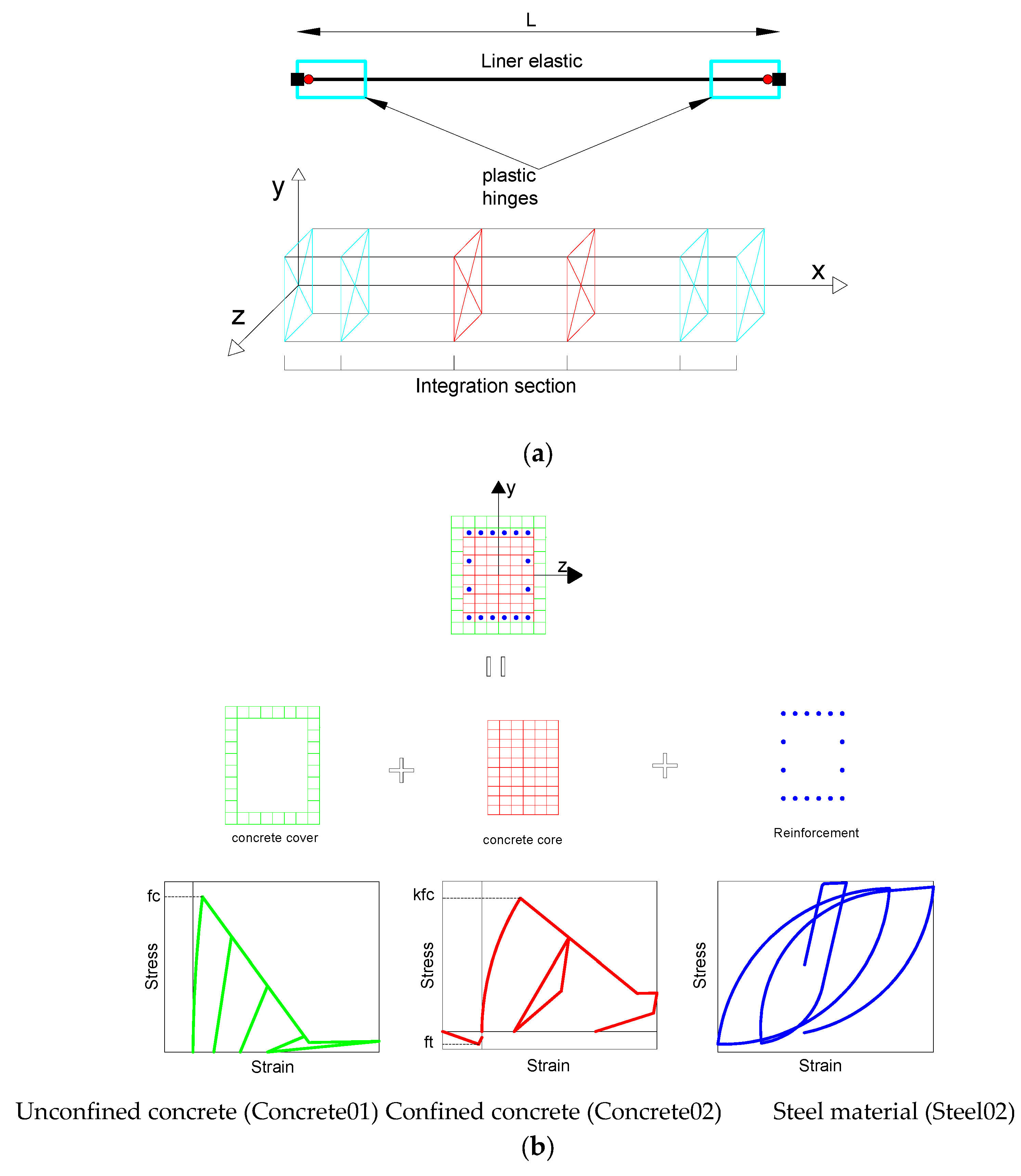
2.2. Description of the Modelling Approach for Infilled RC Frames with Openings
3. Validation of the Modelling Approach
3.1. Scale Specimens
3.1.1. Details of the Geometry and Specimens
3.1.2. Material Properties
3.1.3. Test Setup and Loading Protocol
3.2. Full-Scale Specimens
3.2.1. Details of the Geometry and Specimens
3.2.2. Material Properties
3.2.3. Test Setup and Loading Protocol
4. Numerical Results and Discussion
4.1. Scale Specimens without Openings
4.2. Scale Specimens with Openings
4.3. Full-Scale Specimens without Openings
5. Main Conclusions
- Despite minor discrepancies in the unloading stiffness and dissipated energy, the numerical models adequately represented the global behavior of the specimens.
- This study confirmed that the model can adequately replicate the experiment’s failure modes, ultimate strength, and stiffness, with a reasonable match to the experimental results.
- A maximum deviation of the prediction of the initial stiffness and of the maximum strength of around 23% and 14% were found, respectively.
- However, quantifying the main parameters of the single strut model using the existing model can lead to huge errors; therefore, the mechanical properties shown in Table 5 were defined using the experimental data by tuning the mechanical properties of the strut to get the best fit. By comparing the obtained parameters with those found in the literature, it was found that there are significant differences between the obtained values and the conventional values that depends on the masonry configuration and geometric properties. Figure 18 shows a direct comparison between all the specimens tested in terms of the different performance indicators studied in this work.
Author Contributions
Funding
Data Availability Statement
Conflicts of Interest
References
- McKenna, F.; Fenves, G. The OpenSees Command Language Manual: Version 1.2; 2001. Available online: https://opensees.berkeley.edu/OpenSees/OpenSeesCommands.pdf (accessed on 2 February 2024).
- Scott, M.H.; Fenves, G.L.; McKenna, F.; Filippou, F.C. Software Patterns for Nonlinear Beam-Column Models. J. Struct. Eng. 2008, 134, 562–571. [Google Scholar] [CrossRef]
- Scott, M.H.; Ryan, K.L. Moment-Rotation Behavior of Force-Based Plastic Hinge Elements. Earthq. Spectra 2013, 29, 597–607. [Google Scholar] [CrossRef]
- O’Reilly, G.J.; Sullivan, T.J. Modeling Techniques for the Seismic Assessment of the Existing Italian RC Frame Structures. J. Earthq. Eng. 2019, 23, 1262–1296. [Google Scholar] [CrossRef]
- Paulay, T.; Priestley, M.J.N. Seismic Design of Reinforced Concrete and Masonry Buildings; John Wiley & Sons, Inc.: Hoboken, NJ, USA, 1992. [Google Scholar]
- Hendry, A.W. Design of Masonry Structures; Third Edition of Load Bearing Brickwork Design; Department of Civil Engineering, University of Edinburgh: Edinburgh, UK, 1997. [Google Scholar]
- Dolsek, M.; Fajfar, P. The Effect of Masonry Infills on the Seismic Response of a Four-Storey Reinforced Concrete Frame: A Deterministic Assessment. Eng. Struct. 2008, 30, 1991–2001. [Google Scholar] [CrossRef]
- Mohamed, H.; Romão, X. Analysis of the Performance of Strut Models to Simulate the Seismic Behaviour of Masonry Infills in Partially Infilled RC Frames. Eng. Struct. 2020, 222, 111124. [Google Scholar] [CrossRef]
- Liberatore, L.; Sorrentino, L.; Liberatore, D.; Decanini, L.D. Failure of Industrial Structures Induced by the Emilia (Italy) 2012 Earthquakes. Eng. Fail Anal. 2013, 34, 629–647. [Google Scholar] [CrossRef]
- Asteris, P.G.; Antoniou, S.T.; Sophianopoulos, D.S.; Chrysostomou, C.Z. Mathematical Macromodeling of Infilled Frames: State of the Art. J. Struct. Eng. 2011, 137, 1508–1517. [Google Scholar] [CrossRef]
- Polyakov, S.V. Masonry in Framed Buildings (An Investigation into the Strength and Stiffness of Masonry Infilling); Translated from the Russian by Cairns, G.L., Moscow, 1956; National Lending Library for Science and Technology: Boston Spa, Yorkshire, 1963. [Google Scholar]
- Holmes, M. Combined Loading on Infilled Frames. Proc. Inst. Civ. Eng. 1963, 25, 31–38. [Google Scholar] [CrossRef]
- Stafford Smith, B. Lateral Stiffness of Infilled Frames. Proc. Am. Soc. Civ. Eng. 1962, 88, 183–199. [Google Scholar]
- Mainstone, R.J. On the Stiffnesses and Strengths of Infilled Frames. Proc. Inst. Civ. Eng. 1971, IV, 57–90. [Google Scholar]
- Abdul-Kadir, M.R. Structural Behaviour of Masonry Infill Panels in Framed Structures. Ph.D. Thesis, University of Edinburgh: Edinburgh, UK, 1974. [Google Scholar]
- Klingner, R.E.; Bertero, V.V. Earthquake Resistance of Infilled Frames. J. Struct. Div. 1978, 104, 973–989. [Google Scholar] [CrossRef]
- Leuchars, J.M.; Scrivener, J.C. Masonry Infill Panels Subjected to Cyclic In-Plane Loading. Bull. N. Z. Soc. Earthq. Eng. 1976, 9, 122–131. [Google Scholar] [CrossRef]
- Thiruvengadam, V. On the Natural Frequencies of Infilled Frames. Earthq. Eng. Struct. Dyn. 1985, 13, 401–419. [Google Scholar] [CrossRef]
- Syrmakezis, C.; Vratsanou, V. Influence of Infill Walls to RC Frames Response. In Proceedings of the 8th European Conference on Earthquake Engineering Lisbon, Lisbon, Portugal, 7–12 September 1986. [Google Scholar]
- Chrysostomou, C. Effects of Degrading Infill Walls on the Nonlinear Seismic Response of Two-Dimensional Steel Frames. Ph.D. Thesis, Cornell University: Ithaca, NY, USA, 1991. [Google Scholar]
- Hamburguer, R.; Chakradeo, A. Methodology for Seismic-Capacity Evaluation of Steel-Frame Buildings with Infill Unreinforced Masonry. In Proceedings of the National Earthquake Conference, Central US Earthquake Consortium, Memphis, TN, USA, 2–5 May 1993. [Google Scholar]
- Saneinejad, A.; Hobbs, B. Inelastic Design of Infilled Frames. J. Struct. Eng. 1995, 121, 634–650. [Google Scholar] [CrossRef]
- Crisafulli, F.J.; Carr, A.J.; Park, R. Analytical Modelling of Infilled Frames Structures—A General Review. Bull. N. Z. Soc. Earthq. Eng. 2000, 33, 30–47. [Google Scholar]
- El-Dakhakhni, W.W.; Elgaaly, M.; Hamid, A.A. Three-Strut Model for Concrete Masonry-Infilled Steel Frames. J. Struct. Eng. 2003, 129, 177–185. [Google Scholar] [CrossRef]
- Kadysiewski, S.; Mosalam, K. Modeling of Unreinforced Masonry Infill Walls Considering In-Plane and Out-of-Plane Interaction; PEER 2008/102; University of California: Berkeley, CA, USA, 2009; Volume 144. [Google Scholar]
- Furtado, A.; Rodrigues, H.; Arêde, A.; Varum, H. Simplified Macro-Model for Infill Masonry Walls Considering the out-of-Plane Behaviour. Earthq. Eng. Struct. Dyn. 2016, 45, 507–524. [Google Scholar] [CrossRef]
- Celarec, D.; Ricci, P.; Dolšek, M. The Sensitivity of Seismic Response Parameters to the Uncertain Modelling Variables of Masonry-Infilled Reinforced Concrete Frames. Eng. Struct. 2012, 35, 165–177. [Google Scholar] [CrossRef]
- Di Domenico, M.; De Risi, M.T.; Ricci, P.; Verderame, G.M.; Manfredi, G. Empirical Prediction of the In-Plane/out-of-Plane Interaction Effects in Clay Brick Unreinforced Masonry Infill Walls. Eng. Struct. 2021, 227, 111438. [Google Scholar] [CrossRef]
- Dias-Oliveira, J.; Rodrigues, H.; Asteris, P.G.; Varum, H. On the Seismic Behavior of Masonry Infilled Frame Structures. Buildings 2022, 12, 1146. [Google Scholar] [CrossRef]
- Puglisi, M.; Uzcategui, M.; Flórez-López, J. Modeling of Masonry of Infilled Frames, Part I: The Plastic Concentrator. Eng. Struct. 2009, 31, 113–118. [Google Scholar] [CrossRef]
- McKenna, F. OpenSees: A Framework for Earthquake Engineering Simulation. Comput. Sci. Eng. 2011, 13, 58–66. [Google Scholar] [CrossRef]
- Scott, M.H.; Fenves, G.L. Plastic Hinge Integration Methods for Force-Based Beam–Column Elements. J. Struct. Eng. 2006, 132, 244–252. [Google Scholar] [CrossRef]
- Hendry, A.W. Structural Masonry; Macmillan: Houndmills Basingstoke, UK, 1990; ISBN 9780333497487. [Google Scholar]
- Decanini, L.D.; Liberatore, L.; Mollaioli, F. Strength and Stiffness Reduction Factors for Infilled Frames with Openings. Earthq. Eng. Eng. Vib. 2014, 13, 437–454. [Google Scholar] [CrossRef]
- Kakaletsis, D.J.; Karayannis, C.G. Influence of masonry strength and openings on infilled R/C frames under cycling loading. J. Earthq. Eng. 2008, 12, 197–221. [Google Scholar] [CrossRef]
- Furtado, A.; Rodrigues, H.; Arede, A.; Varum, H. Experimental investigation on the possible effect of previous damage, workmanship and test setup on the out-of-plane behaviour of masonry infill walls. J. Earthq. Eng. 2022, 26, 5647–5678. [Google Scholar] [CrossRef]
- Asteris, P.G.; Cotsovos, D.M.; Chrysostomou, C.Z.; Mohebkhah, A.; Al-Chaar, G.K. Mathematical Micromodeling of Infilled Frames: State of the Art. Eng. Struct. 2013, 56, 1905–1921. [Google Scholar] [CrossRef]
- EN 1998-1-3; Eurocode 8. Design of Structures for Earthquake Resistance—Part 1–3: Strengthening and Repair of Buildings, CEN. European Committee for Standardization: Brussels, Belgium, 2005.
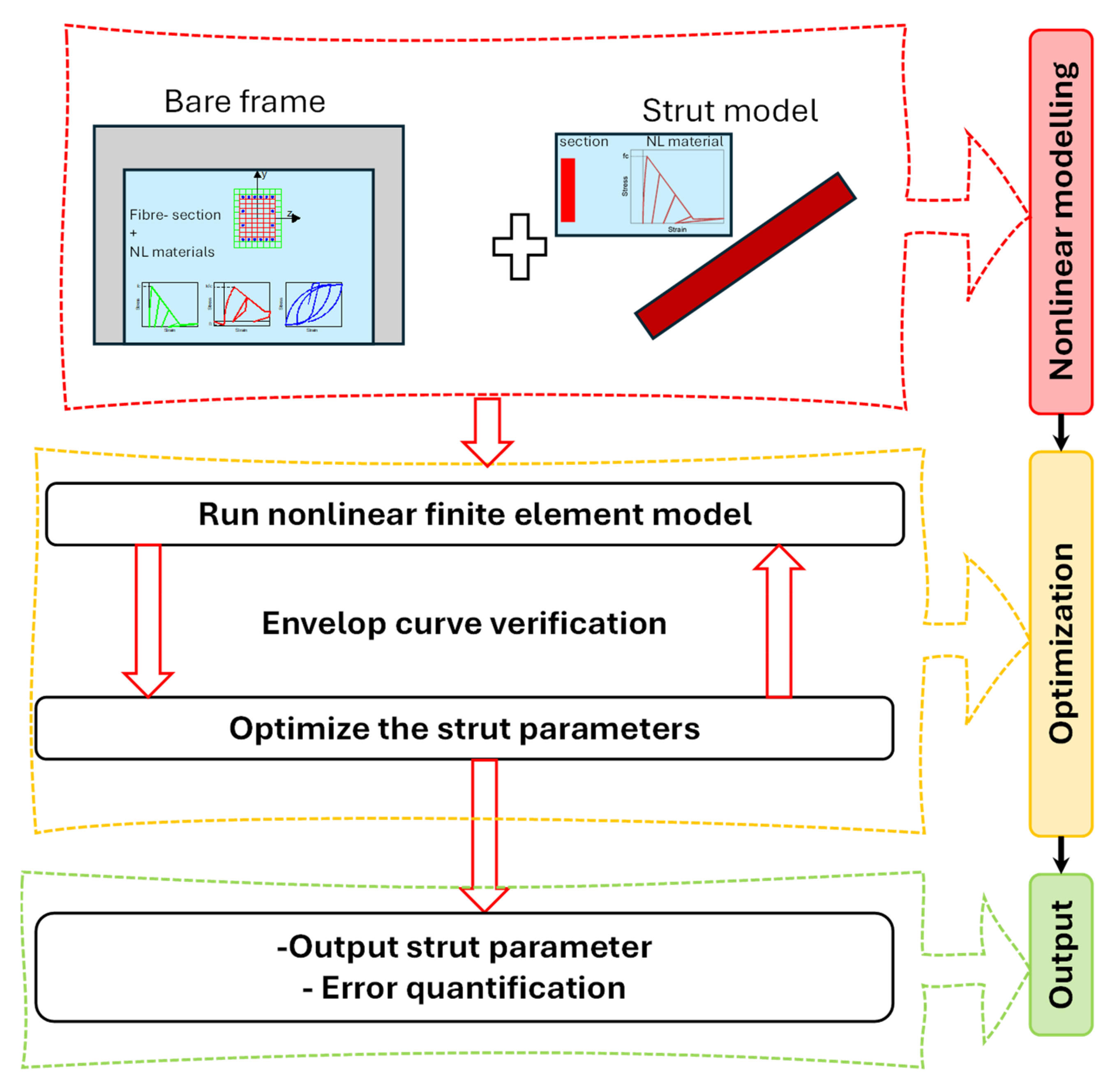
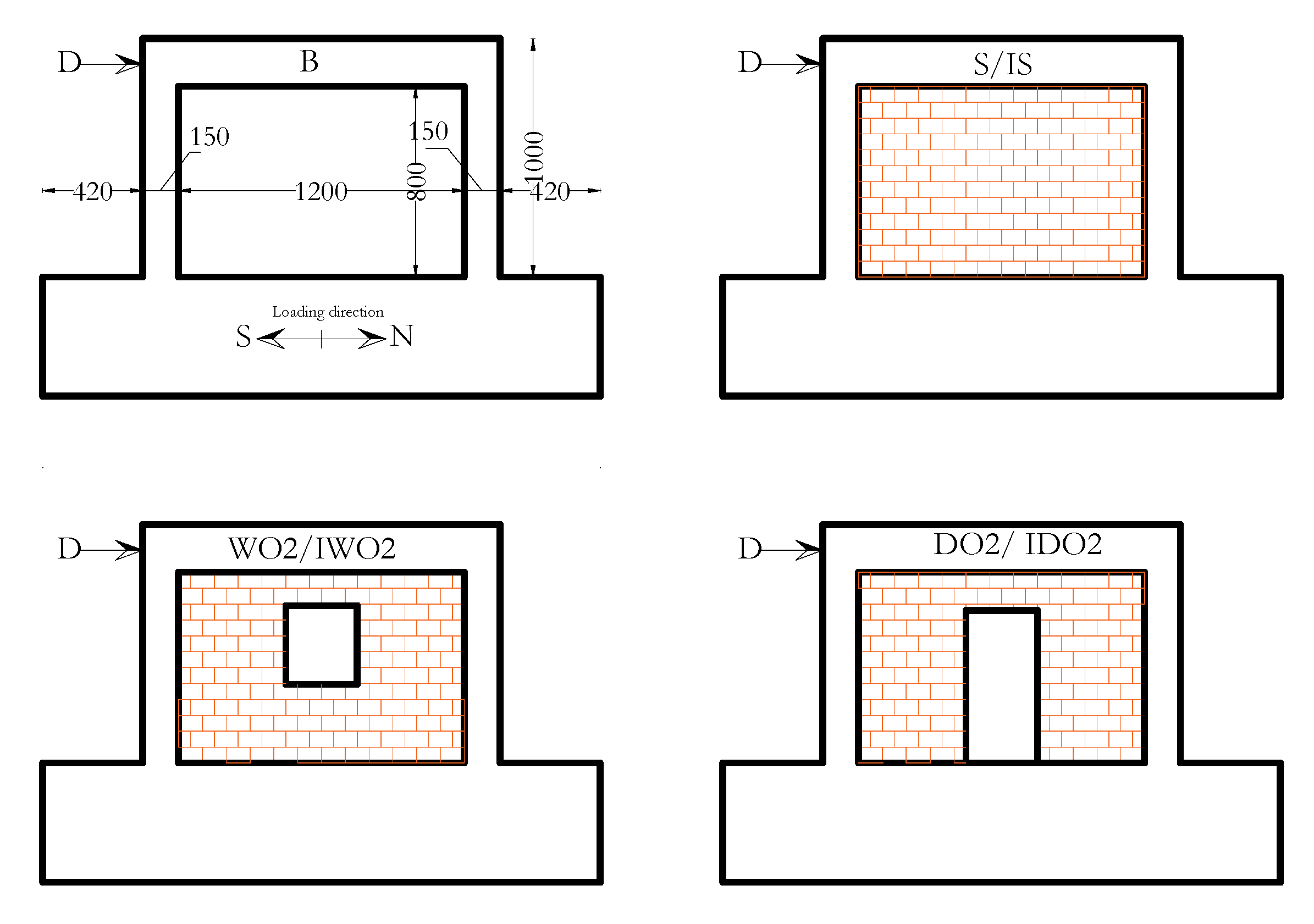

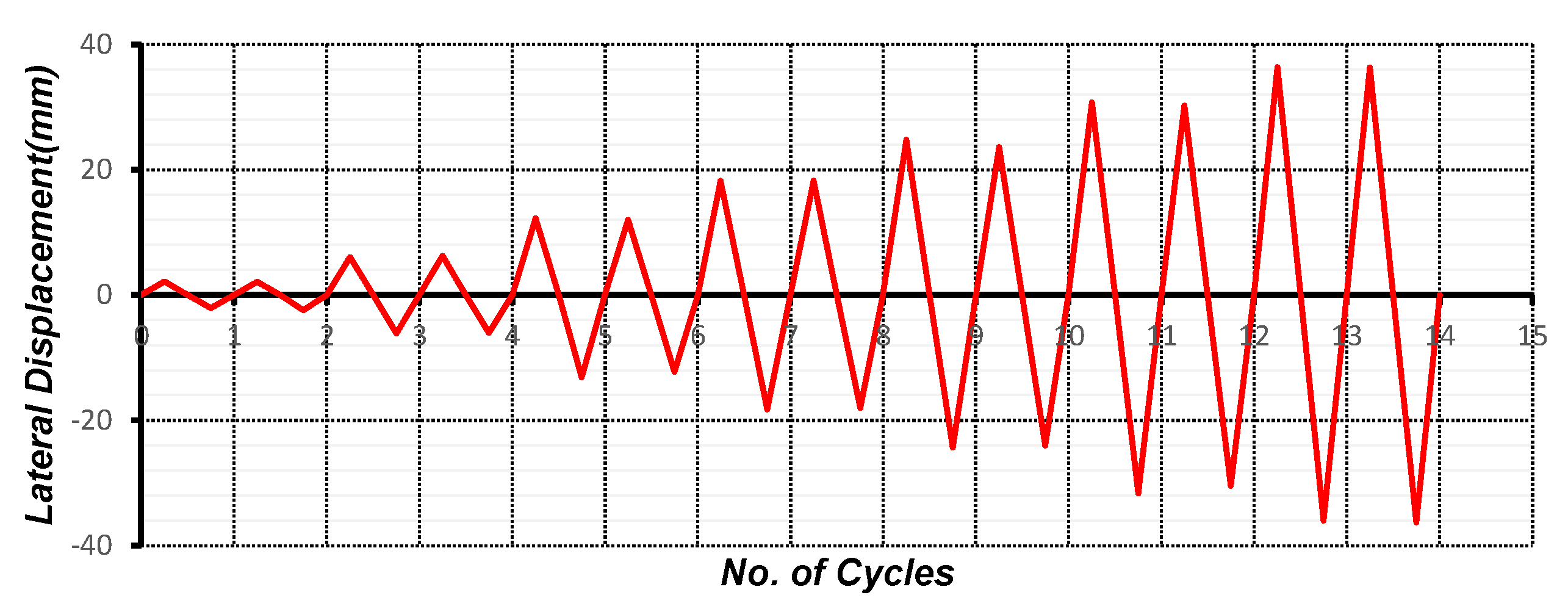
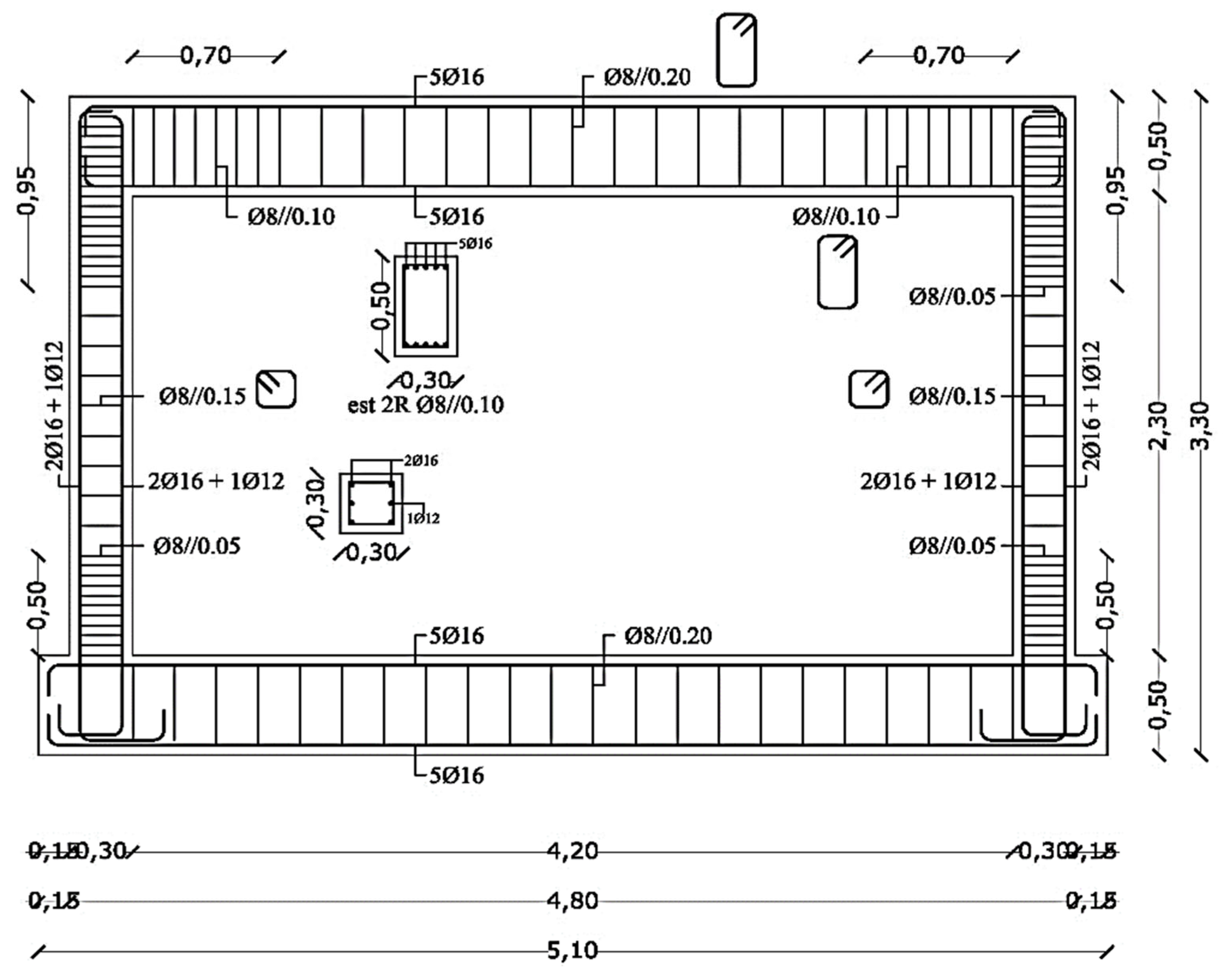
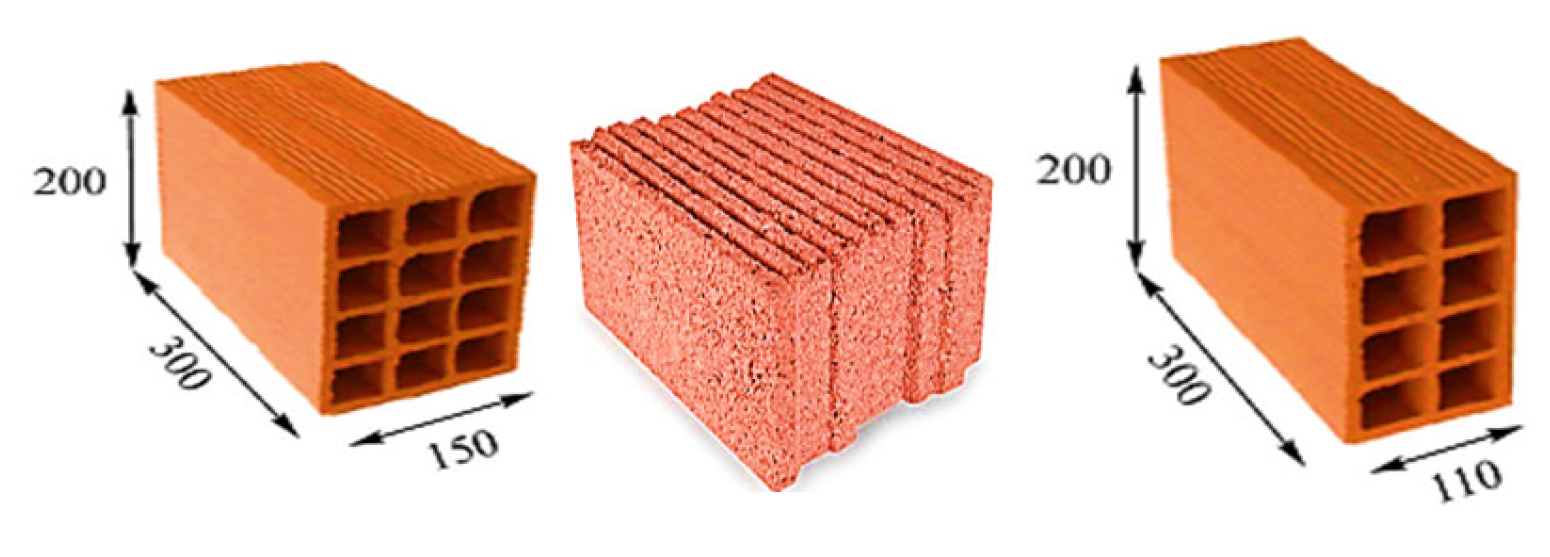
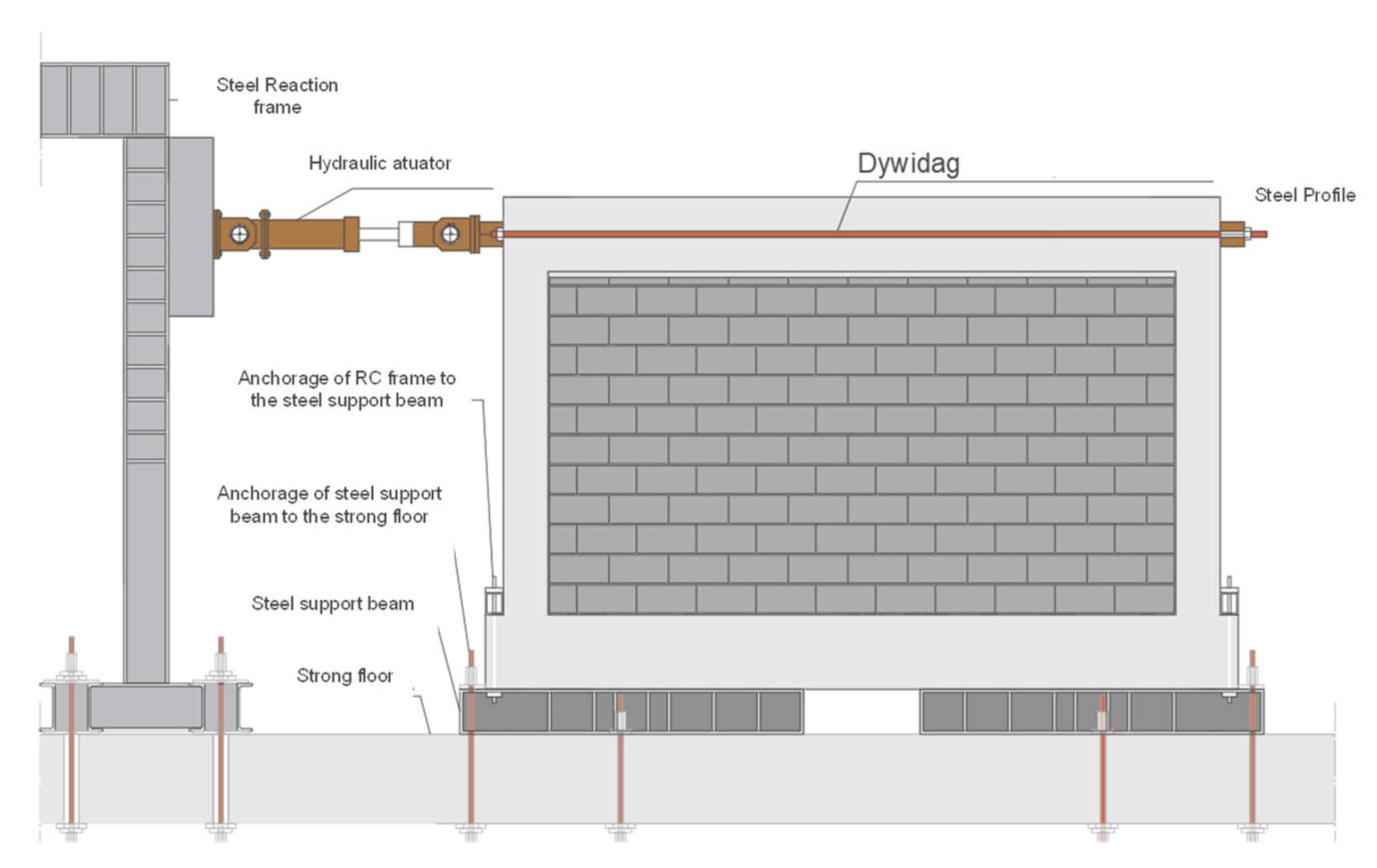

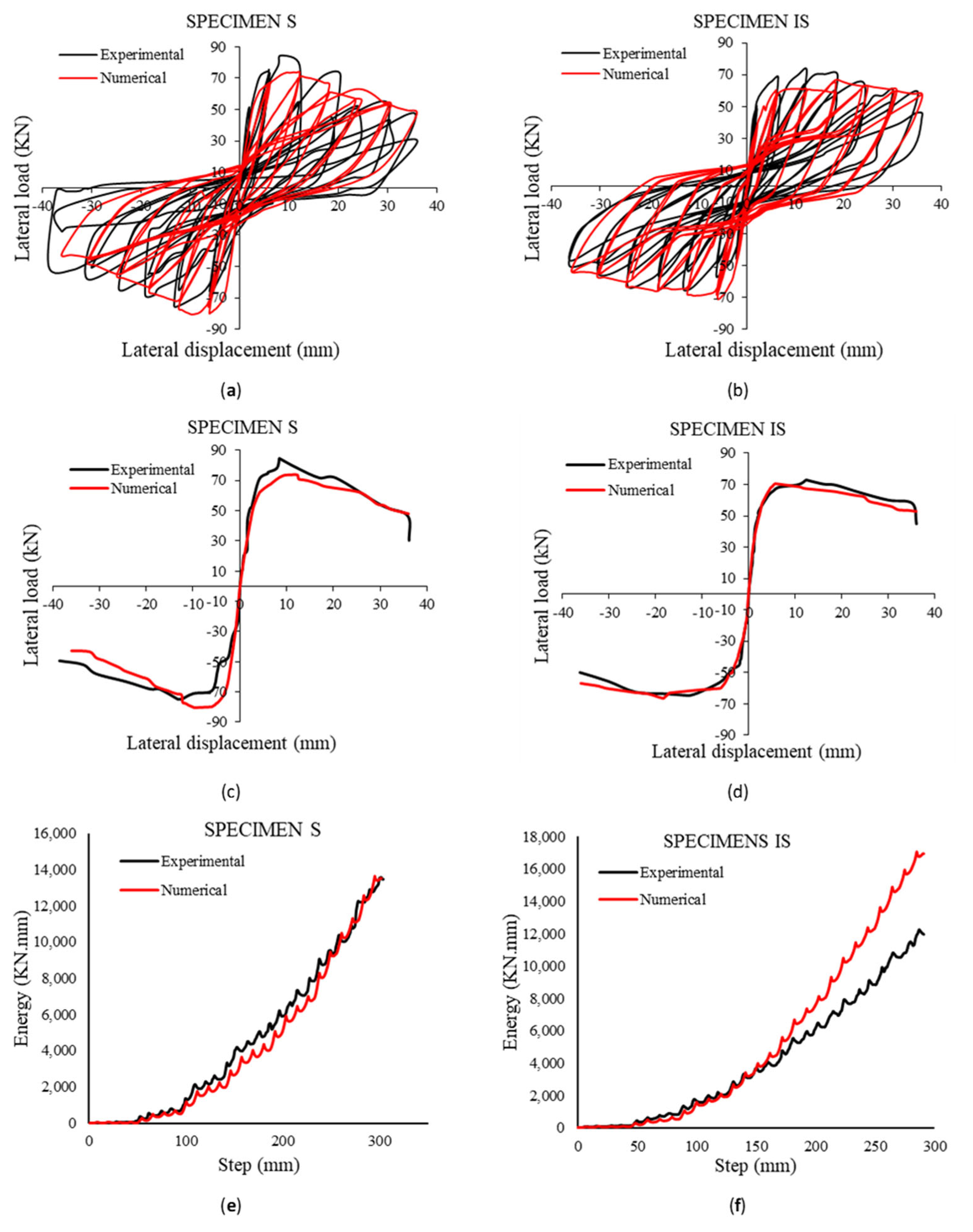

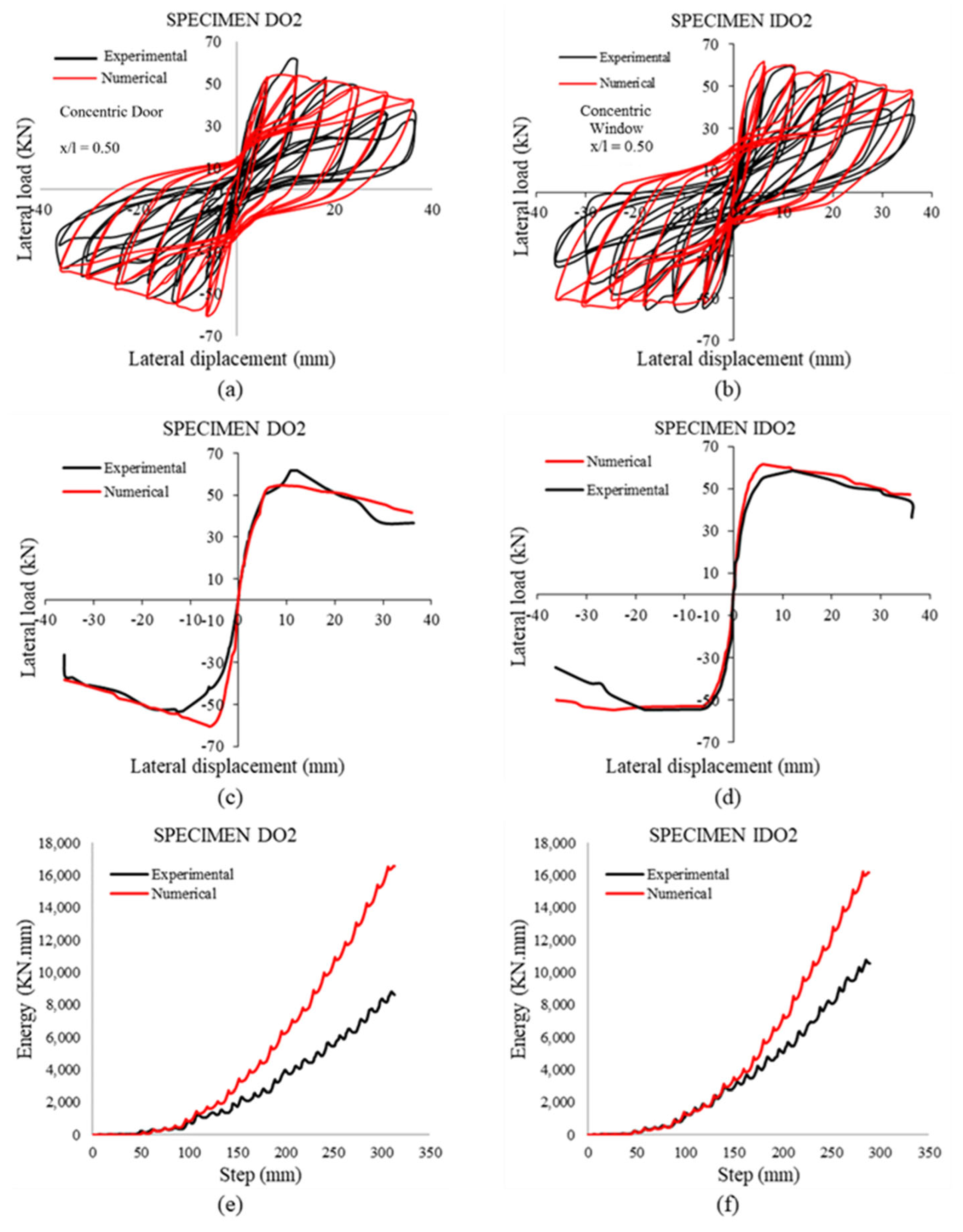
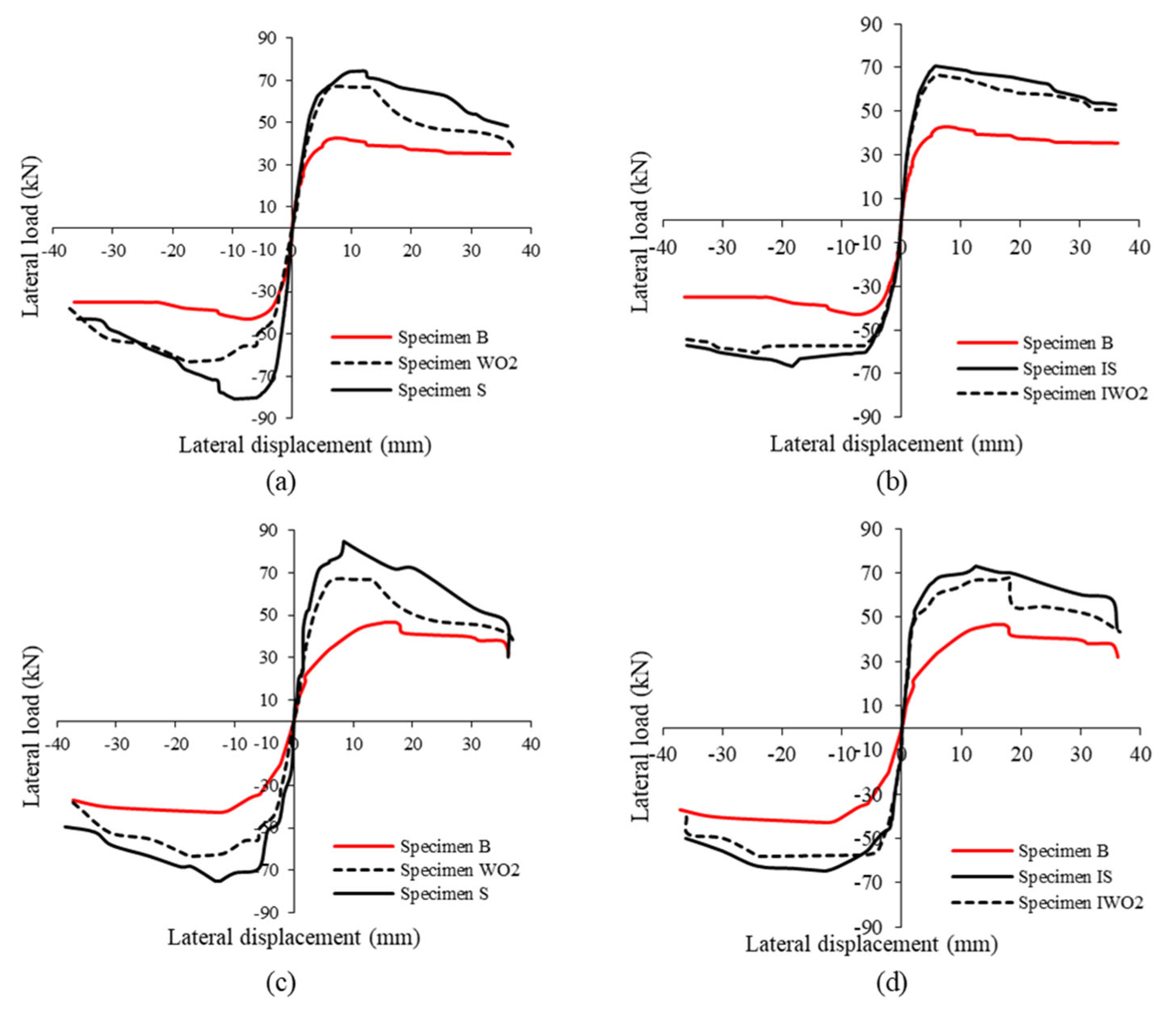


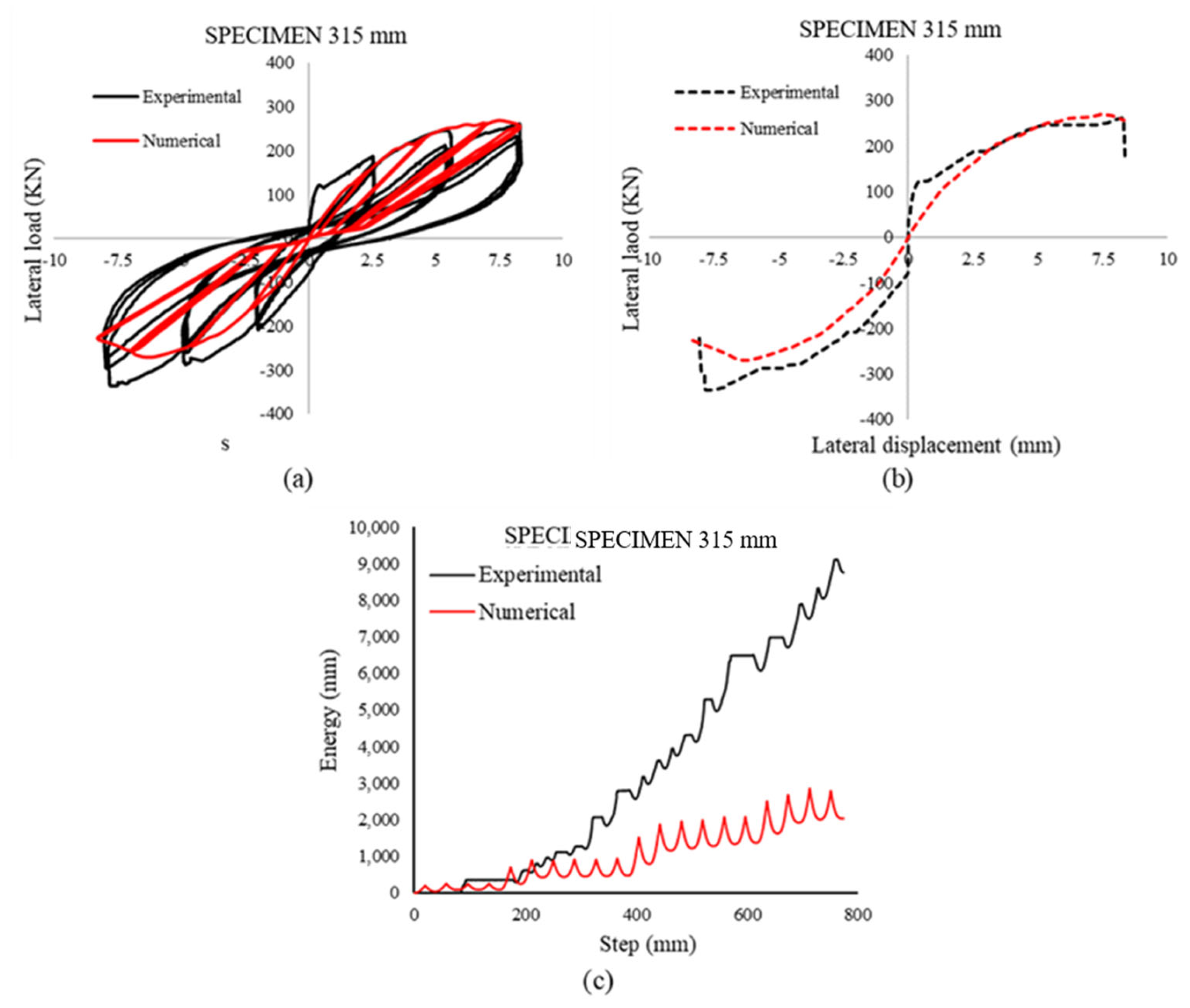


| Specimen Notation | Opening Shape | Opening Size Opening Width (La)/Wall Width (L) = 0.25 | Opening Location Distance to Opening Centre (X)/Wall Width (L) = 0.5 | Masonry Type | ||
|---|---|---|---|---|---|---|
| Window | Door | Weak | Strong | |||
| B | Bare frame | Bare frame | ----- | ------ | ||
| S | Solid | Solid | ----- | ------ | ■ | |
| IS | Solid | Solid | ----- | ----- | ■ | |
| WO2 | ■ | ■ | ■ | ■ | ||
| IWO2 | ■ | ■ | ■ | ■ | ||
| DO2 | ■ | ■ | ■ | ■ | ||
| IDO2 | ■ | ■ | ■ | ■ | ||
| Mechanical Properties | Values per Type of Masonry | |
|---|---|---|
| Weak | Strong | |
| Mortar | ||
| Compressive strength (MPa) | 1.53 | 1.75 |
| Brick units | ||
| Compressive strength (MPa) | 3.10 | 26.4 |
| Masonry walls | ||
| Compressive strength perpendicular to voids (MPa) | 2.63 | 15.18 |
| Elastic modulus perpendicular to voids (MPa) | 660.66 | 2837.14 |
| Compressive strength parallel to voids (MPa) | 5.11 | 17.68 |
| Elastic modulus parallel to voids (MPa) | 670.30 | 540.19 |
| Friction coefficient | 0.770 | 0.957 |
| Shear modulus (MPa) | 259.39 | 351.37 |
| Mechanical Properties | Values (unit) |
|---|---|
| Frame | |
| Compressive strength | 28.51 (MPa) |
| Steel bars | |
| Yield tensile strength of longitudinal steel | 390.47 (MPa) |
| Ultimate tensile strength of longitudinal steel | 516.27 (MPa) |
| Yield tensile strength of transverse steel | 212.20 (MPa) |
| Ultimate tensile strength of transverse steel | 321.07 (MPa) |
| Component | Material Properties | Specimen 150 mm | Specimen 315 mm | Specimen 110 mm | ||||||
|---|---|---|---|---|---|---|---|---|---|---|
| Average Value (MPa) | CoV (%) | SD (MPa) | Average Value (MPa) | CoV (%) | SD (MPa) | Average Value (MPa) | CoV (%) | SD (MPa) | ||
| Concrete | Compressive strength | 22.85 | 6.1 | 0.88 | 22.85 | 6.1 | 0.88 | 22.85 | 6.1 | 0.88 |
| Steel rebars | Elastic modulus | 24,300 | 0.9 | 210 | 24,300 | 0.9 | 210 | 24,300 | 0.9 | 210 |
| Elastic modulus | ||||||||||
| Φ8 mm | 198,000 | 5.4 | 10,692 | 19,800 | 5.4 | 10,692 | 198,000 | 5.4 | 10692 | |
| ϕ12 mm | 192,000 | 6.2 | 11,904 | 192,000 | 6.2 | 11,904 | 192,000 | 6.2 | 11,904 | |
| ϕ16 mm | 187,000 | 2.1 | 3927 | 187,000 | 2.1 | 3927 | 187,000 | 2.1 | 3927 | |
| Yielding stress | ||||||||||
| Φ8 mm | 535 | 2.2 | 11.8 | 535 | 2.2 | 11.8 | 535 | 2.2 | 11.8 | |
| ϕ10 mm | 526 | 3.5 | 18.4 | 526 | 3.5 | 18.4 | 526 | 3.5 | 18.4 | |
| ϕ16 mm | 532 | 3.2 | 17.1 | 532 | 3.2 | 17.1 | 532 | 3.2 | 17.1 | |
| Masonry wallets | Compressive strength parallel to the vertical hollows | 0.806 | 12.81 | 0.14 | 1.82 | 5.1 | 0.09 | 0.66 | 19.68 | 0.131 |
| Elastic modulus parallel to the vertical hollows | 1975 | 36.7 | 719 | 3251 | 10.9 | 355 | 1837 | 30.6 | 563 | |
| Diagonal tensile strength | 0.645 | 22.2 | 0.143 | 0.204 | 5.7 | 0.01 | 0.565 | 35.2 | 0.199 | |
| Shear straining | 996 | 8.91 | 88.7 | 1389 | 36.1 | 501 | 1141 | 11.8 | 135 | |
| Flexural strength parallel to the bed joints | 0.139 | 12.63 | 0.018 | 0.08 | 14.2 | 0.01 | 0.117 | 4.26 | 0.005 | |
| Flexural strength perpendicular to the bed joints | 0.322 | 18.1 | 0.058 | 0.17 | 25.2 | 0.04 | 0.271 | 30.3 | 0.083 | |
| Specimens | Area of Strut (m2) | fm (kPa) | ε0 (%) | εu (%) | fres (kPa) | Diagonal Length (m) | Wall Thickness | Factor to Diagonal Length | ||
|---|---|---|---|---|---|---|---|---|---|---|
| IS | 0.0189 | 2248 | 0.0028 | 0.016 | 1420 | 63.16726 | 1.5 | 0.052 | 15600 | 0.24 |
| IDO2 | 0.0129 | 2248 | 0.0028 | 0.016 | 1420 | 63.16726 | 1.5 | 0.052 | 15600 | 0.17 |
| IWO2 | 0.0150 | 2248 | 0.0028 | 0.016 | 1420 | 63.16726 | 1.5 | 0.052 | 15600 | 0.19 |
| S | 0.0185 | 2925 | 0.0046 | 0.016 | 732 | 25.02564 | 1.5 | 0.06 | 2600 | 0.21 |
| WO2 | 0.0185 | 2086.8 | 0.00375 | 0.016 | 411 | 19.69523 | 1.5 | 0.06 | 2600 | 0.21 |
| DO2 | 0.0185 | 1442 | 0.00317 | 0.016 | 107 | 7.42025 | 1.5 | 0.06 | 2600 | 0.21 |
| Specimen 150 | 0.1800 | 1090 | 0.0007 | 0.006 | 272 | 24.95413 | 4.8 | 0.15 | 1090 | 0.25 |
| Specimen 110 | 0.1320 | 1020 | 0.0003 | 0.0013 | 102 | 10 | 4.8 | 0.11 | 1020 | 0.25 |
| Specimen 315 | 0.1390 | 1800 | 0.001 | 0.002 | 180 | 10 | 4.8 | 0.31 | 1800 | 0.09 |
Disclaimer/Publisher’s Note: The statements, opinions and data contained in all publications are solely those of the individual author(s) and contributor(s) and not of MDPI and/or the editor(s). MDPI and/or the editor(s) disclaim responsibility for any injury to people or property resulting from any ideas, methods, instructions or products referred to in the content. |
© 2024 by the authors. Licensee MDPI, Basel, Switzerland. This article is an open access article distributed under the terms and conditions of the Creative Commons Attribution (CC BY) license (https://creativecommons.org/licenses/by/4.0/).
Share and Cite
Messaoudi, A.; Chebili, R.; Mohamed, H.; Furtado, A.; Rodrigues, H. The In-Plane Seismic Response of Infilled Reinforced Concrete Frames Using a Strut Modelling Approach: Validation and Applications. Buildings 2024, 14, 1902. https://doi.org/10.3390/buildings14071902
Messaoudi A, Chebili R, Mohamed H, Furtado A, Rodrigues H. The In-Plane Seismic Response of Infilled Reinforced Concrete Frames Using a Strut Modelling Approach: Validation and Applications. Buildings. 2024; 14(7):1902. https://doi.org/10.3390/buildings14071902
Chicago/Turabian StyleMessaoudi, Abdelghaffar, Rachid Chebili, Hossameldeen Mohamed, André Furtado, and Hugo Rodrigues. 2024. "The In-Plane Seismic Response of Infilled Reinforced Concrete Frames Using a Strut Modelling Approach: Validation and Applications" Buildings 14, no. 7: 1902. https://doi.org/10.3390/buildings14071902
APA StyleMessaoudi, A., Chebili, R., Mohamed, H., Furtado, A., & Rodrigues, H. (2024). The In-Plane Seismic Response of Infilled Reinforced Concrete Frames Using a Strut Modelling Approach: Validation and Applications. Buildings, 14(7), 1902. https://doi.org/10.3390/buildings14071902









